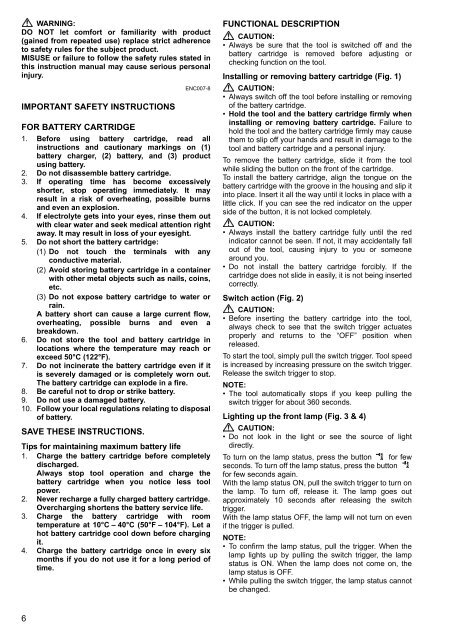Makita Visseuse oléopneumatique 18 V Li-Ion 40 Nm (Machine seule) - DTS141Z - Notice
Makita Visseuse oléopneumatique 18 V Li-Ion 40 Nm (Machine seule) - DTS141Z - Notice
Makita Visseuse oléopneumatique 18 V Li-Ion 40 Nm (Machine seule) - DTS141Z - Notice
Create successful ePaper yourself
Turn your PDF publications into a flip-book with our unique Google optimized e-Paper software.
WARNING:<br />
DO NOT let comfort or familiarity with product<br />
(gained from repeated use) replace strict adherence<br />
to safety rules for the subject product.<br />
MISUSE or failure to follow the safety rules stated in<br />
this instruction manual may cause serious personal<br />
injury.<br />
IMPORTANT SAFETY INSTRUCTIONS<br />
ENC007-8<br />
FOR BATTERY CARTRIDGE<br />
1. Before using battery cartridge, read all<br />
instructions and cautionary markings on (1)<br />
battery charger, (2) battery, and (3) product<br />
using battery.<br />
2. Do not disassemble battery cartridge.<br />
3. If operating time has become excessively<br />
shorter, stop operating immediately. It may<br />
result in a risk of overheating, possible burns<br />
and even an explosion.<br />
4. If electrolyte gets into your eyes, rinse them out<br />
with clear water and seek medical attention right<br />
away. It may result in loss of your eyesight.<br />
5. Do not short the battery cartridge:<br />
(1) Do not touch the terminals with any<br />
conductive material.<br />
(2) Avoid storing battery cartridge in a container<br />
with other metal objects such as nails, coins,<br />
etc.<br />
(3) Do not expose battery cartridge to water or<br />
rain.<br />
A battery short can cause a large current flow,<br />
overheating, possible burns and even a<br />
breakdown.<br />
6. Do not store the tool and battery cartridge in<br />
locations where the temperature may reach or<br />
exceed 50°C (122°F).<br />
7. Do not incinerate the battery cartridge even if it<br />
is severely damaged or is completely worn out.<br />
The battery cartridge can explode in a fire.<br />
8. Be careful not to drop or strike battery.<br />
9. Do not use a damaged battery.<br />
10. Follow your local regulations relating to disposal<br />
of battery.<br />
SAVE THESE INSTRUCTIONS.<br />
Tips for maintaining maximum battery life<br />
1. Charge the battery cartridge before completely<br />
discharged.<br />
Always stop tool operation and charge the<br />
battery cartridge when you notice less tool<br />
power.<br />
2. Never recharge a fully charged battery cartridge.<br />
Overcharging shortens the battery service life.<br />
3. Charge the battery cartridge with room<br />
temperature at 10°C – <strong>40</strong>°C (50°F – 104°F). Let a<br />
hot battery cartridge cool down before charging<br />
it.<br />
4. Charge the battery cartridge once in every six<br />
months if you do not use it for a long period of<br />
time.<br />
FUNCTIONAL DESCRIPTION<br />
CAUTION:<br />
• Always be sure that the tool is switched off and the<br />
battery cartridge is removed before adjusting or<br />
checking function on the tool.<br />
Installing or removing battery cartridge (Fig. 1)<br />
CAUTION:<br />
• Always switch off the tool before installing or removing<br />
of the battery cartridge.<br />
• Hold the tool and the battery cartridge firmly when<br />
installing or removing battery cartridge. Failure to<br />
hold the tool and the battery cartridge firmly may cause<br />
them to slip off your hands and result in damage to the<br />
tool and battery cartridge and a personal injury.<br />
To remove the battery cartridge, slide it from the tool<br />
while sliding the button on the front of the cartridge.<br />
To install the battery cartridge, align the tongue on the<br />
battery cartridge with the groove in the housing and slip it<br />
into place. Insert it all the way until it locks in place with a<br />
little click. If you can see the red indicator on the upper<br />
side of the button, it is not locked completely.<br />
CAUTION:<br />
• Always install the battery cartridge fully until the red<br />
indicator cannot be seen. If not, it may accidentally fall<br />
out of the tool, causing injury to you or someone<br />
around you.<br />
• Do not install the battery cartridge forcibly. If the<br />
cartridge does not slide in easily, it is not being inserted<br />
correctly.<br />
Switch action (Fig. 2)<br />
CAUTION:<br />
• Before inserting the battery cartridge into the tool,<br />
always check to see that the switch trigger actuates<br />
properly and returns to the “OFF” position when<br />
released.<br />
To start the tool, simply pull the switch trigger. Tool speed<br />
is increased by increasing pressure on the switch trigger.<br />
Release the switch trigger to stop.<br />
NOTE:<br />
• The tool automatically stops if you keep pulling the<br />
switch trigger for about 360 seconds.<br />
<strong>Li</strong>ghting up the front lamp (Fig. 3 & 4)<br />
CAUTION:<br />
• Do not look in the light or see the source of light<br />
directly.<br />
To turn on the lamp status, press the button for few<br />
seconds. To turn off the lamp status, press the button<br />
for few seconds again.<br />
With the lamp status ON, pull the switch trigger to turn on<br />
the lamp. To turn off, release it. The lamp goes out<br />
approximately 10 seconds after releasing the switch<br />
trigger.<br />
With the lamp status OFF, the lamp will not turn on even<br />
if the trigger is pulled.<br />
NOTE:<br />
• To confirm the lamp status, pull the trigger. When the<br />
lamp lights up by pulling the switch trigger, the lamp<br />
status is ON. When the lamp does not come on, the<br />
lamp status is OFF.<br />
• While pulling the switch trigger, the lamp status cannot<br />
be changed.<br />
6
















